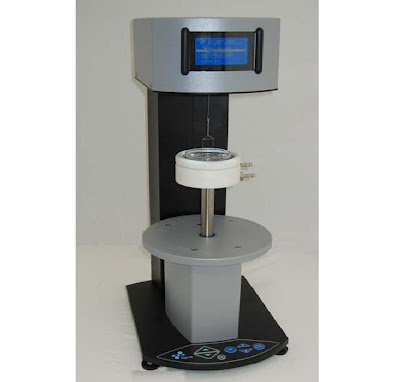
Performing an interfacial tension measurement
between water / oil according to ASTM D971 standard.
1. Check the instructions in section 5.1 and make necessary preparations.
2. Set oil density to correct value. You may also measure the density of the
oil (see section 5.2).
3. Make sure that the correction method of your preference is selected. You
can change the active ring correction method from Adjust parameters
menu. To be strictly compliant with ASTM D971 standard, choose
Zuidema-Waters. However, Huh-Mason is a more modern method that is
generally regarded more accurate.
4. Pour distilled water at a temperature of 25 ± 1°C into cleaned sample
container to a depth of 10 to 15 mm. Place it in to the middle of the
tensiometer platform. Make sure no foam is present at the water surface.
If foam is visible, discard the water. Foam indicates that the water is
contaminated or that the vessel is not clean.
5. Mount the ring in the tensiometer hook. If the oil to be measured is denser
than water, the measurement must be performed in Push Mode1, and the
supplied weight therefor needs to be attached to the ring before mounting
the ring.
6. Select "Measure oil interface" from the menu selection and press the OK
button. Sigma will now measure automatically the surface tension of the
water. Wait until the measurement has completed. If the measurement
was successful, the ring will automatically descend back into the water,
except in the case of Push Mode measurement with dense oil, however,
the ring will remain about 5 mm above the water.
7. When the ring has stopped moving, carefully layer the oil on the surface of
the water, until an oil layer of at least 10 mm is reached2. Do not move
the sample container from tensiometer platform, nor move the ring.
8. Press the OK button right after the oil pouring is finished. The tensiometer
will then wait for 29 seconds (as the standard requires a wait between 29
and 31 seconds), until it starts the measurement of the interfacial tension
between water and oil. Wait until the measurement has completed.
9. Interfacial tension value is shown on the display.
As the ring is pulled through a surface or an interface, a curve is plotted,
showing the tension value calculated from the balance reading at each
instant. The highest value encountered will be displayed as the result of the
measurement.
1 If the oil is denser than water, it forms a layer below water and interfacial tension must
measured by pulling the ring downwards from water to oil; hence the name Push Mode. The
case of Push Mode measurement is not explicitly addressed in ASTM D971 standard.
2 Layering the oil should not take more time than 30s since completing the entire interfacial
tension measurement have to be done within 60s ±10s






